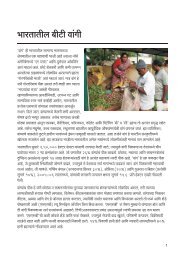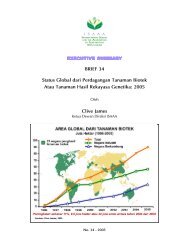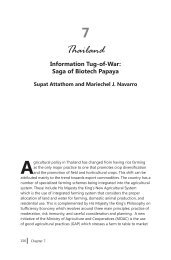Communication Challenges and Convergence in Crop ... - isaaa
Communication Challenges and Convergence in Crop ... - isaaa
Communication Challenges and Convergence in Crop ... - isaaa
Create successful ePaper yourself
Turn your PDF publications into a flip-book with our unique Google optimized e-Paper software.
of biotech crops) namely Ch<strong>in</strong>a, India, Philipp<strong>in</strong>es, <strong>and</strong> Australia; <strong>and</strong> potential<br />
biotech countries of Bangladesh, Malaysia, Thail<strong>and</strong> <strong>and</strong> Vietnam. Except for<br />
Australia’s case study which was authored by a science communication expert<br />
from Australian Government’s Department of Innovation, Industry, Science <strong>and</strong><br />
Research, the rest are written by members of the Global Knowledge Center on<br />
<strong>Crop</strong> Biotechnology as well as the Biotechnology Information Centers (BICs). They<br />
are part of the <strong>in</strong>formation network of the International Service for the Acquisition<br />
of Agri-biotech Applications (ISAAA) <strong>in</strong> Asia, Africa, Lat<strong>in</strong> America, <strong>and</strong> Europe.<br />
The network, along with other public <strong>and</strong> private sector players <strong>in</strong> different<br />
countries are work<strong>in</strong>g together to create an enabl<strong>in</strong>g environment for the safe<br />
application of crop biotechnology; generate, process, <strong>and</strong> package <strong>in</strong>formation on<br />
crop biotechnology; facilitate shar<strong>in</strong>g of knowledge among various stakeholders;<br />
<strong>and</strong> develop <strong>and</strong> validate appropriate science communication modalities.<br />
Case studies of regional science communication activities are presented <strong>in</strong> Part 3.<br />
These showcase <strong>in</strong>ter-country strategies to widen awareness <strong>and</strong> underst<strong>and</strong><strong>in</strong>g<br />
of crop biotechnology as exemplified by activities of the Organization of Islamic<br />
Countries (OIC). Realiz<strong>in</strong>g the importance of science communication <strong>in</strong>itiatives,<br />
<strong>in</strong>itial resources are now be<strong>in</strong>g allotted to <strong>in</strong>stitutionalize such efforts <strong>in</strong> member<br />
countries. Experiences of the plant science <strong>in</strong>dustry <strong>in</strong> knowledge shar<strong>in</strong>g <strong>and</strong><br />
exchange <strong>in</strong> plant biotechnology are also discussed. It notes the need to foster<br />
balanced discussions by engag<strong>in</strong>g stakeholders <strong>in</strong> open conversations; <strong>and</strong> <strong>in</strong><br />
respect<strong>in</strong>g the <strong>in</strong>terconnectedness of ecosystems that <strong>in</strong>tegrates biotechnology<br />
with<strong>in</strong> the gamut of the natural <strong>and</strong> social sciences, <strong>and</strong> ethics.<br />
The last chapter is a synthesis of the case studies consolidat<strong>in</strong>g the lessons<br />
learned on science communication, <strong>and</strong> the way forward. The case studies<br />
show that despite diversity <strong>in</strong> culture, political set-up, economic development,<br />
religious beliefs, <strong>and</strong> language, countries have been able to address specific<br />
communication issues that impede or hasten the development of crop<br />
biotechnology. An appreciation of science communication <strong>and</strong> appropriate<br />
strategies have led to a better underst<strong>and</strong><strong>in</strong>g of the societal environment<br />
where the technology can best thrive. The collective <strong>and</strong> collaborative efforts of<br />
countries <strong>and</strong> regional <strong>in</strong>itiatives have converged to form a consensus on crop<br />
biotechnology.<br />
This book is meant for all those <strong>in</strong>volved <strong>in</strong> science communication. It is not<br />
only for those directly do<strong>in</strong>g work <strong>in</strong> the field, but also to a grow<strong>in</strong>g breed of<br />
stakeholders who view science <strong>and</strong> communication not as separate discipl<strong>in</strong>es,<br />
but as synergistic components necessary to br<strong>in</strong>g about change, development,<br />
<strong>and</strong> transformation <strong>in</strong> <strong>in</strong>dividuals, <strong>in</strong>stitutions, <strong>and</strong> society.<br />
iv<br />
Mariechel J. Navarro <strong>and</strong> R<strong>and</strong>y A. Hautea








